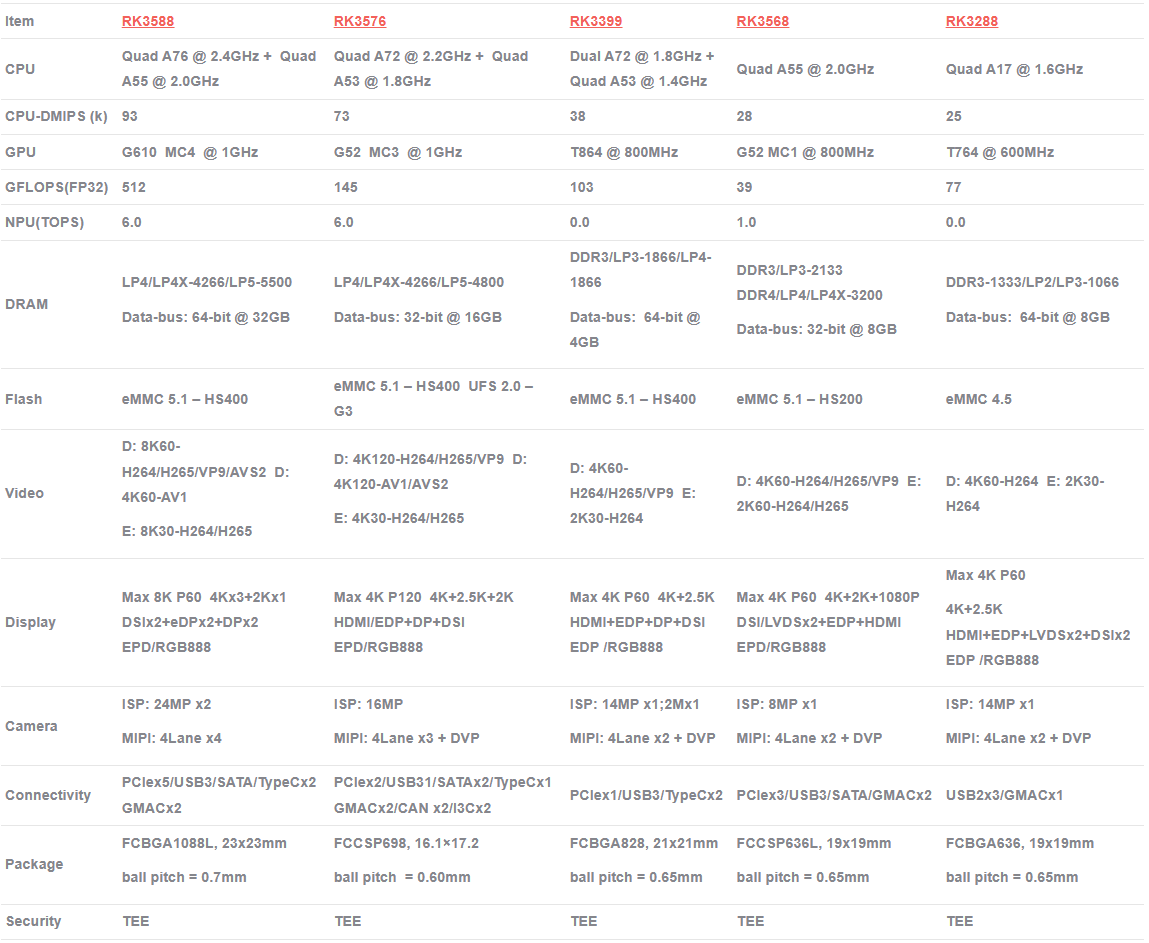Comparative Analysis of RK3576 with RK3588, RK3568, RK3399, RK3288 and Other Mainstream Chips
RK3576, positioned as a sub-flagship chip, primarily offers customers a high cost-performance option. Products based on RK3576 have already started to roll out. Here, we provide a simple comparative analysis of the performance characteristics of RK3576 versus RK3588, RK3568, RK3399, RK3288, and other mainstream chips to facilitate customer selection. Industry clients can conduct comparative analysis based on business requirements to select the appropriate SoC chip for product definition. Below is the comparison of these chips.
From a comparison of the main specification parameters, it is evident that RK3576 has significant advantages in many aspects, with its cost-performance ratio being particularly prominent.

RK3576 vs RK3588 Comparative Analysis
Performance: RK3588, as Rockchip’s flagship industrial processor, possesses superior computing power and AI capabilities. Although RK3576’s performance is slightly lower than RK3588, it still maintains an NPU with 6 TOPS of computing power and supports UFS storage, enabling it to deliver excellent performance in many application scenarios.
Cost-Performance Ratio: Despite RK3588’s stronger performance, RK3576 is more affordable, giving it a clear advantage in terms of cost-performance ratio. This makes RK3576 an ideal choice for application developers seeking high performance with limited budgets.
RK3576 vs RK3568 Comparative Analysis
Performance: RK3576 significantly outperforms RK3568. RK3576 supports higher processing speeds, more powerful graphics processing capabilities, and richer expansion interfaces, capable of meeting more complex application requirements.
Functionality: RK3576 features a built-in independent NPU with computing power more than 6 times that of RK3568. It supports various video codec formats and high-speed interfaces, while RK3568 is relatively weaker in these aspects. This makes RK3576 more competitive in AIoT applications.
RK3576 vs RK3399 Comparative Analysis
Performance: RK3576 significantly outperforms RK3399. With technological advancements, RK3399 has gradually been replaced by new-generation chips like RK3576. RK3576 shows significant improvements in CPU and GPU performance, AI processing capabilities, and other aspects.
Functionality: RK3576 supports more video codec formats and high-speed interfaces, while also featuring a more powerful built-in NPU, giving it an advantage in AIoT applications.
RK3576 vs RK3288 Comparative Analysis
Performance: RK3576 significantly outperforms RK3288. With technological advancements, RK3288 can no longer meet the requirements of some high-performance, high-complexity application scenarios, whereas RK3576 can fulfill these demands.
Functionality: RK3576 has clear advantages in video codec, graphics processing, AI computation, and other aspects, while also supporting more high-speed interfaces and expansion functions, making it more competitive in iterative upgrades of existing products.
Conclusion
In summary, RK3576 has a significant advantage in terms of cost-performance ratio, far surpassing chips like RK3568, RK3399, and RK3288. It is suitable for various application scenarios, especially commercial display devices, video streaming devices, smart classroom hosts, smart home hubs, intelligent monitoring AI devices, industrial control hosts/industrial control boards, robot AI intelligent control boards, automotive electronics, and other embedded systems and intelligent device upgrades.
Choosing RK3576 as an iterative upgrade solution for existing products will bring higher performance and better user experience.